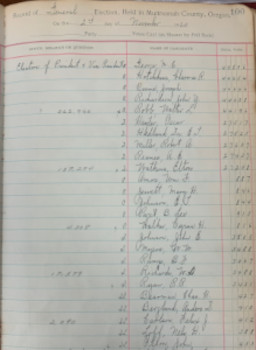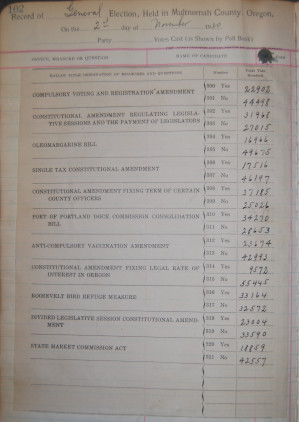> Voting for Women > New Voices in the Elections Process
New Voices in the Elections Process

Multnomah County Record of Elections, p. 100, Electors of President and Vice-President in General Election, November 2, 1920, Records of the Elections Division, Multnomah County Archives.
In November of 1920, new female voters in Multnomah County cast their ballots not only for local and federal candidates, but also on proposed ordinances and measures. That year, the mayoral and commissioner races went to incumbents. This was no real surprise, as both candidates beat out their opponents by wide margins. Voters also elected Walter L. Robb with a majority of the votes (222,940) to serve as elector. Robb would become a member of the electoral college, which determines the President and the Vice President of the United States. He was a Republican whose slogan in the Oregon Voter: Magazine of Citizenship — for Busy Men and Women was “Lived in Oregon 40 years, and always a Republican.”
Women voters may not have heavily influenced that year’s elections of officials, but some of the issues they were voting on then have endured and continue to be divisive subjects even today.
On the November 1920 ballot, new women voters considered issues like:
- Compulsory Voting and Registration Amendment (NO – 44498 to 22902 votes) and
- Oleomargarine Bill (NO – 49675 to 16966 votes)

Multnomah County Record of Elections, p. 102, Ballot Measures for General Election, 2 Nov 1920, Records of the Elections Division, Multnomah County Archives.
The Oleomargarine bill may have been of interest to the many women who listed their occupation as housewives on their voter registration cards. The NO vote on this bill meant that there would be no regulation on the manufacture and sale of butter substitutes.
The more serious Compulsory Voting and Registration Amendment would have required all people eligible to vote to cast a ballot. Notably, although this would have included women, it would not have included Indigenous women who were not married to white men, or first generation Asian immigrants (male or female) because neither were counted as citizens under the xenophobic laws of the time. Indigenous women finally gained voting rights in 1924, but Asian immigrants did not achieve this right until 1952.
<<Previous: Ellen Ravenscroft | Next: Suffrage and Prohibition>>

